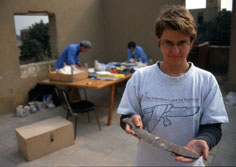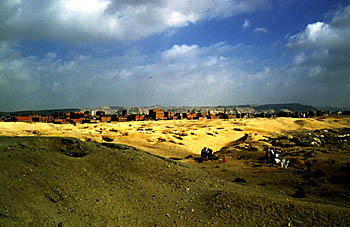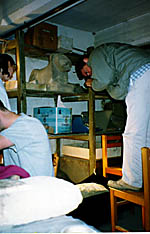Copyright
© 1997 - 2001 Macquarie University
Original
location: http://www.pr.mq.edu.au/events/index.asp?ItemID=38
MACQUIRE
UNIVERSITY HOMEPAGE
Six new Egyptian tombs discovered
by Macquarie archaeologists
Archaeologists from the Australian
Centre for Egyptology at Macquarie University have discovered six previously
unknown tombs – dating back to 3000 BC – at the ancient cemetery of Helwan on
the southern outskirts of modern Cairo.
 This 100 ha site
is regarded as the necropolis of Egypt’s first capital city, Memphis, and
the six new tombs discovered there over the Australian summer (2000/2001)
were built hundreds of years before the Pyramids.
This 100 ha site
is regarded as the necropolis of Egypt’s first capital city, Memphis, and
the six new tombs discovered there over the Australian summer (2000/2001)
were built hundreds of years before the Pyramids.
“In Egypt today, discovering unexcavated tombs of such an early date is very
rare. After four years of tough fieldwork we have finally hit pay dirt.” project
director Dr Christiana Kohler said.
Amongst the six new tombs to have been excavated is that of a mature female
who was buried in a large wooden chest. The richness and number of her grave
goods suggest that she was a wealthy matron of early Memphis.
Dr Kohler said the most significant discovery was an intact 30 centimetre
long flint knife.
“Very few of these beautifully crafted knives have survived, and its presence
helps us to date this tomb to the First Dynasty of the Kings of the ancient
Egyptian state.” (A photograph of Dr Kohler holding this flint knife is available
on request).
Another tomb discovered contained the well-preserved skeleton of a young female
who was aged between 16 and 18 years when she died. In the simple wooden coffin
her family had placed small calcite juglets, jars and bowls for scented oils
and cosmetics as well as an ivory spoon and bone spatula in the belief that
she would want to apply make-up and be well groomed in the afterlife.
Why she died so young remains a mystery, but her bones will be studied by
a physical anthropologist next season for clues to the cause of death.
These two new tombs and three others are located around or underneath a much
larger tomb of 10 by 17 metres which was also found in the 2000/2001 season.
Its full exploration also awaits the next field season.
After finishing the on-site work in late January this year, Dr Kohler and
her team of Macquarie students and Egyptologists worked for a month in the
Egyptian Museum (Cairo) where they drew and photographed around two hundred
pieces of jewellery originally from Helwan.
This museum work is part of the on-going efforts of Dr Kohler to analyse,
photograph and draw for the first time the several thousand objects that were
found in the 1940’s and 1950’s by the first excavator of the Early Dynastic
cemetery at Helwan, Egyptian archaeologist Zaki Saad.
Dr Kohler believes that the careful study of these finds, combined with continuing
excavations on-site will allow a detailed picture of early Memphis’s social
structure, funerary customs and history to be developed.

